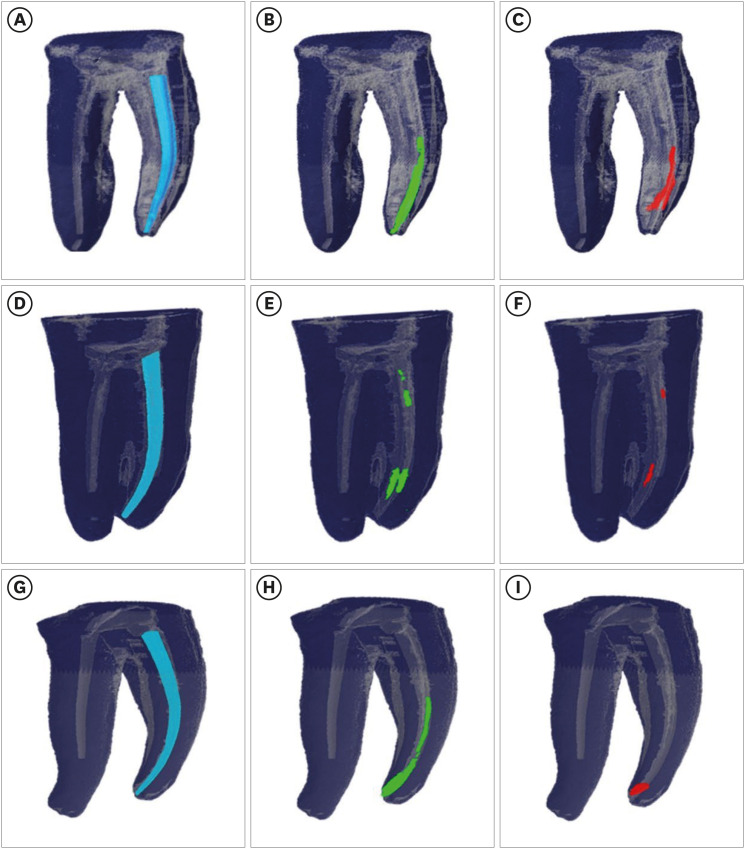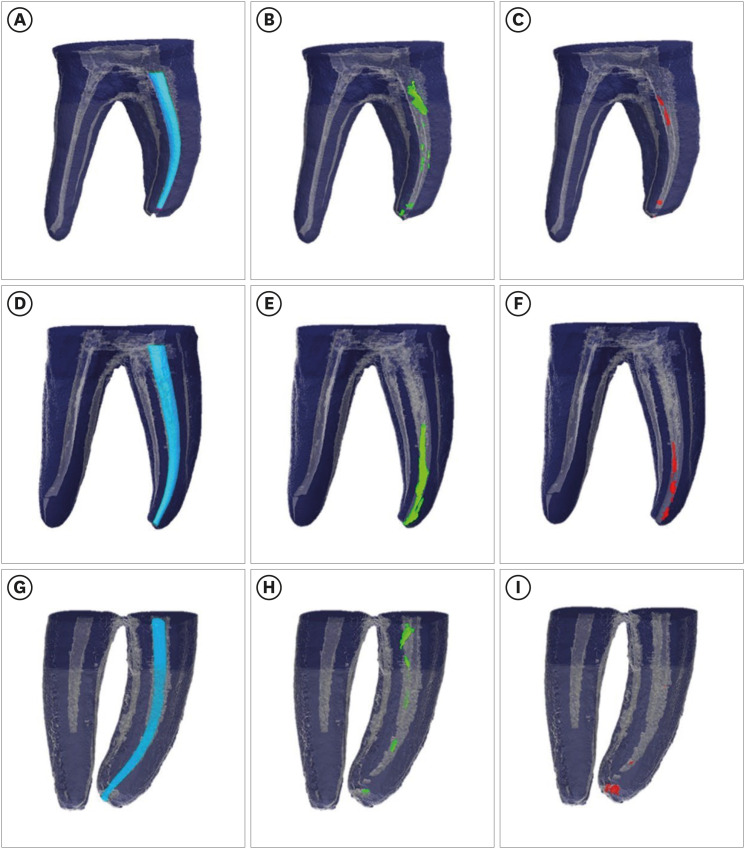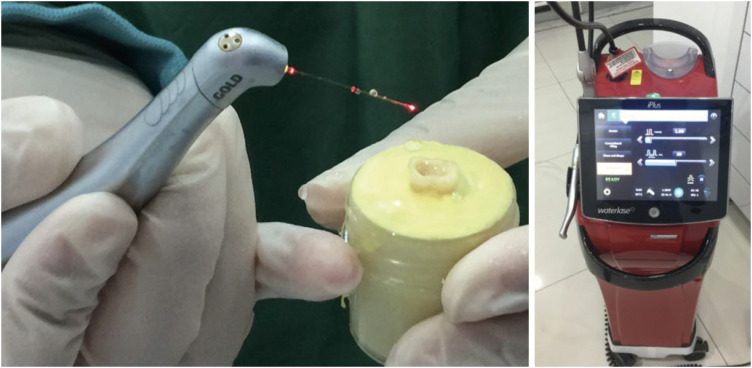1. Ng YL, Mann V, Gulabivala K. A prospective study of the factors affecting outcomes of nonsurgical root canal treatment: part 1: periapical health. Int Endod J. 2011; 44:583–609. PMID:
21366626.

2. Silva EJ, Belladonna FG, Zuolo AS, Rodrigues E, Ehrhardt IC, Souza EM, et al. Effectiveness of XP-Endo Finisher and XP-Endo Finisher R in removing root filling remnants: a micro-CT study. Int Endod J. 2018; 51:86–91. PMID:
28467618.

3. Zuolo AS, Mello JE Jr, Cunha RS, Zuolo ML, Bueno CE. Efficacy of reciprocating and rotary techniques for removing filling material during root canal retreatment. Int Endod J. 2013; 46:947–953. PMID:
23506150.

4. Gu LS, Ling JQ, Wei X, Huang XY. Efficacy of ProTaper Universal rotary retreatment system for gutta-percha removal from root canals. Int Endod J. 2008; 41:288–295. PMID:
18081804.

5. Ersev H, Yilmaz B, Dinçol ME, Dağlaroğlu R. The efficacy of ProTaper Universal rotary retreatment instrumentation to remove single gutta-percha cones cemented with several endodontic sealers. Int Endod J. 2012; 45:756–762. PMID:
22432937.

6. De-Deus G, Arruda TE, Souza EM, Neves A, Magalhães K, Thuanne E, et al. The ability of the Reciproc R25 instrument to reach the full root canal working length without a glide path. Int Endod J. 2013; 46:993–998. PMID:
23560929.

7. Crozeta BM, Silva-Sousa YT, Leoni GB, Mazzi-Chaves JF, Fantinato T, Baratto-Filho F, et al. Micro-computed tomography study of filling material removal from oval-shaped canals by using rotary, reciprocating, and adaptive motion systems. J Endod. 2016; 42:793–797. PMID:
26987688.

8. Borges MM, Duque JA, Zancan RF, Vivan RR, Bernardes RA, Duarte MA. Efficacy of reciprocating systems for removing root filling material plus complementary cleaning methods in flattened canals: microtomography and scanning electron microscopy study. Microsc Res Tech. 2019; 82:1057–1064. PMID:
30889319.

9. Özyürek T, Yılmaz K, Uslu G. Shaping ability of Reciproc, WaveOne GOLD, and HyFlex EDM single-file systems in simulated S-shaped canals. J Endod. 2017; 43:805–809. PMID:
28292599.

10. Alberton CS, Tomazinho FS, Calefi PS, Duarte MA, Vivan RR, Baratto-Filho F. Influence of the preparation order in 4-canal maxillary molars with WaveOne Gold system. J Endod. 2020; 46:1291–1296. PMID:
32531311.

11. Delai D, Jardine AP, Mestieri LB, Boijink D, Fontanella VR, Grecca FS, et al. Efficacy of a thermally treated single file compared with rotary systems in endodontic retreatment of curved canals: a micro-CT study. Clin Oral Investig. 2019; 23:1837–1844.

12. Alves FR, Roças IN, Provenzano JC, Flávio RF, Siqueira JF Jr. Removal of the previous root canal filling material for retreatment: implications and techniques. Appl Sci. 2022; 12:10217.

13. Alves FR, Marceliano-Alves MF, Sousa JC, Silveira SB, Provenzano JC, Siqueira JF Jr. Removal of root canal fillings in curved canals using either reciprocating single-or rotary multi-instrument systems and a supplementary step with the XP-Endo Finisher. J Endod. 2016; 42:1114–1119. PMID:
27215810.

14. Metzger Z. The self-adjusting file (SAF) system: an evidence-based update. J Conserv Dent. 2014; 17:401–419. PMID:
25298639.

15. Papoulidou I, Dionysopoulos D, Mourouzis P, Naka O, Sarris K, Baldi A, et al. Evaluation of Er,Cr:YSGG laser technique for fiber post removal of endodontically treated teeth using micro-computed tomography. Microsc Res Tech. 2023; 86:803–812. PMID:
37158449.

16. Diaci J, Gaspirc B. Comparison of Er: YAG and Er, Cr: YSGG lasers used in dentistry. J Laser Health Acad. 2012; 1:1–13.
17. Bolhari B, Ehsani S, Etemadi A, Shafaq M, Nosrat A. Efficacy of Er,Cr:YSGG laser in removing smear layer and debris with two different output powers. Photomed Laser Surg. 2014; 32:527–532. PMID:
25198390.

18. Helvacioglu-Yigit D, Yilmaz A, Kiziltas-Sendur G, Aslan OS, Abbott PV. Efficacy of reciprocating and rotary systems for removing root filling material: a micro-computed tomography study. Scanning. 2014; 36:576–581. PMID:
25168273.

19. Schneider SW. A comparison of canal preparations in straight and curved root canals. Oral Surg Oral Med Oral Pathol. 1971; 32:271–275. PMID:
5284110.

20. Costa PM, Leal RM, Yamanari GH, Cavenago BC, Duarte MA. Effectiveness of endodontic retreatment using WaveOne Primary files in reciprocating and rotary motions. Restor Dent Endod. 2023; 48:e15. PMID:
37284343.

21. Lee JK, Yoo YJ, Perinpanayagam H, Ha BH, Lim SM, Oh SR, et al. Three-dimensional modelling and concurrent measurements of root anatomy in mandibular first molar mesial roots using micro-computed tomography. Int Endod J. 2015; 48:380–389. PMID:
24889320.

22. Rödig T, Reicherts P, Konietschke F, Dullin C, Hahn W, Hülsmann M. Efficacy of reciprocating and rotary NiTi instruments for retreatment of curved root canals assessed by micro-CT. Int Endod J. 2014; 47:942–948. PMID:
24386931.

23. Özyürek T, Demiryürek EÖ. Efficacy of different nickel-titanium instruments in removing gutta-percha during root canal retreatment. J Endod. 2016; 42:646–649. PMID:
26898565.

24. Canali LC, Duque JA, Vivan RR, Bramante CM, Só MV, Duarte MA. Comparison of efficiency of the retreatment procedure between Wave One Gold and Wave One systems by micro-CT and confocal microscopy: an
in vitro study. Clin Oral Investig. 2019; 23:337–343.

25. Bago I, Plotino G, Katić M, Ročan M, Batinić M, Anić I. Evaluation of filling material remnants after basic preparation, apical enlargement and final irrigation in retreatment of severely curved root canals in extracted teeth. Int Endod J. 2020; 53:962–973. PMID:
32159859.

26. Azim AA, Wang HH, Tarrosh M, Azim KA, Piasecki L. Comparison between single-file rotary systems: part 1-efficiency, effectiveness, and adverse effects in endodontic retreatment. J Endod. 2018; 44:1720–1724. PMID:
30243662.

27. Aksel H, Küçükkaya Eren S, Askerbeyli Örs S, Serper A, Ocak M, Çelik HH. Micro-CT evaluation of the removal of root fillings using the ProTaper Universal Retreatment system supplemented by the XP-Endo Finisher file. Int Endod J. 2019; 52:1070–1076. PMID:
30715732.

28. Rodrigues RC, Antunes HS, Neves MA, Siqueira JF Jr, Rôças IN. Infection control in retreatment cases:
in vivo antibacterial effects of 2 instrumentation systems. J Endod. 2015; 41:1600–1605. PMID:
26234543.

29. Tachinami H, Katsuumi I. Removal of root canal filling materials using Er:YAG laser irradiation. Dent Mater J. 2010; 29:246–252. PMID:
20495285.

30. Abduljalil M, Kalender A. Efficacy of Er,Cr:YSGG laser with different output powers on removing smear layer after retreatment of two different obturation techniques. Photobiomodul Photomed Laser Surg. 2020; 38:84–90. PMID:
31339812.

31. Abad-Gallegos M, Arnabat-Domínguez J, España-Tost A, Berini-Aytés L, Gay-Escoda C.
In vitro evaluation of the temperature increment at the external root surface after Er,Cr:YSGG laser irradiation of the root canal. Med Oral Patol Oral Cir Bucal. 2009; 14:e658–e662. PMID:
19680194.
32. Mohammadi Z. Laser applications in endodontics: an update review. Int Dent J. 2009; 59:35–46. PMID:
19323310.
33. Hülsmann M, Drebenstedt S, Holscher C. Shaping and filling root canals during root canal re-treatment. Endod Topics. 2008; 19:74–124.

34. Paranjpe A, de Gregorio C, Gonzalez AM, Gomez A, Silva Herzog D, Piña AA, et al. Efficacy of the self-adjusting file system on cleaning and shaping oval canals: a microbiological and microscopic evaluation. J Endod. 2012; 38:226–231. PMID:
22244642.

35. Sağlam BC, Koçak MM, Türker SA, Koçak S. Efficacy of different solvents in removing gutta-percha from curved root canals: a micro-computed tomography study. Aust Endod J. 2014; 40:76–80. PMID:
24118310.

36. Takahashi CM, Cunha RS, de Martin AS, Fontana CE, Silveira CF, da Silveira Bueno CE.
In vitro evaluation of the effectiveness of ProTaper universal rotary retreatment system for gutta-percha removal with or without a solvent. J Endod. 2009; 35:1580–1583. PMID:
19840652.

37. Karataş E, Kol E, Bayrakdar İŞ, Arslan H. The effect of chloroform, orange oil and eucalyptol on root canal transportation in endodontic retreatment. Aust Endod J. 2016; 42:37–40. PMID:
26420757.

38. Oyama KO, Siqueira EL, Santos M.
In vitro study of effect of solvent on root canal retreatment. Braz Dent J. 2002; 13:208–211. PMID:
12428599.
39. Salgado KR, de Castro RF, Prado MC, Brandão GA, da Silva JM, da Silva EJ. Cleaning ability of irrigants and orange oil solvent combination in the removal of root canal filling materials. Eur Endod J. 2018; 4:33–37. PMID:
32161884.
40. Rodrigues CT, Duarte MA, de Almeida MM, de Andrade FB, Bernardineli N. Efficacy of CM-wire, M-Wire, and nickel-titanium instruments for removing filling material from curved root canals: a micro–computed tomography study. J Endod. 2016; 42:1651–1655. PMID:
27651042.

41. Karatas E, Gunduz HA, Kirici DO, Arslan H. Incidence of dentinal cracks after root canal preparation with ProTaper Gold, Profile Vortex, F360, Reciproc and ProTaper Universal instruments. Int Endod J. 2016; 49:905–910. PMID:
26384589.

42. Simões LP, Dos Reis-Prado AH, Bueno CR, Viana AC, Duarte MA, Cintra LT, et al. Effectiveness and safety of rotary and reciprocating kinematics for retreatment of curved root canals: a systematic review of
in vitro studies. Restor Dent Endod. 2022; 47:e22. PMID:
35692221.









 PDF
PDF Citation
Citation Print
Print






 XML Download
XML Download